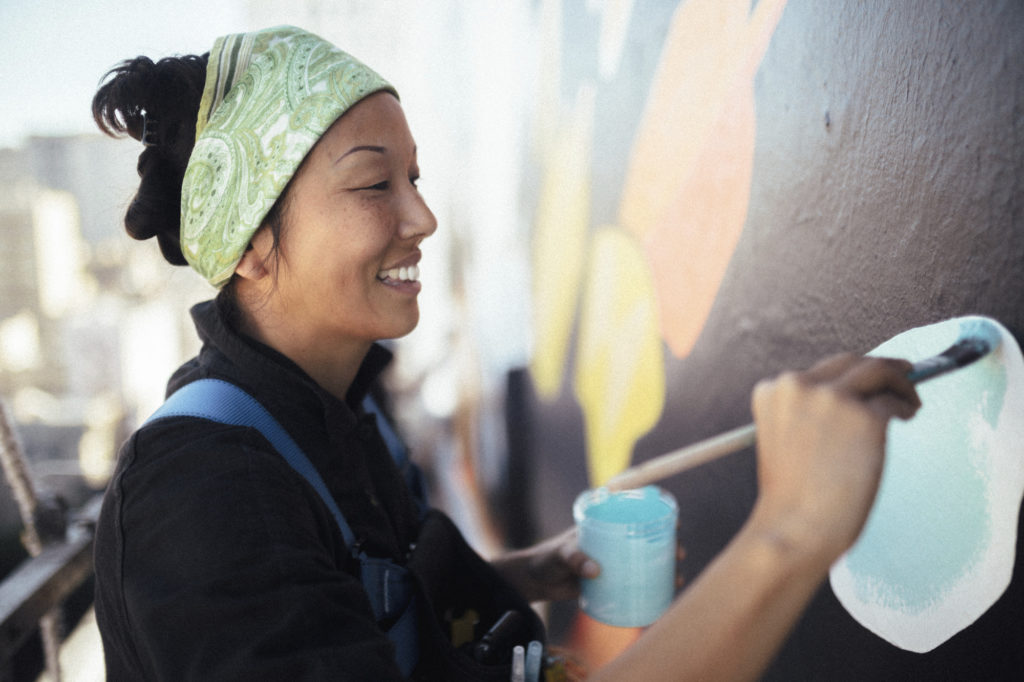Conservation and Vibrant Color: Painting Le Papillon at 455 Hyde
January 9th, 2020
The Tenderloin is one of San Francisco’s oldest neighborhoods and cultural centers, with a long tradition of creating art and supporting artists. 11-story, 50-foot high murals covering three sides of 455 Hyde Street – a collaboration between Veritas, Bay Area art studio Ink Dwell, and the Xerces Society for Invertebrate Conservation as part of Ink Dwell’s nationwide Migrating Mural project – are the latest addition to that legacy.
Ink Dwell’s Jane Kim and Thayer Walker have extensive experience planning and executing large-scale public artworks, but 455 Hyde features their grandest work yet. The in-progress project is a testament to careful planning, teamwork, and talent, with a radiant energy and magnificent colors that already stop passersby in their tracks. Kim and Walker walked us through the process of painting the latest installment of the Migrating Mural: three distinct works on the north, south, and front walls of the building, Le Papillon.
Step 1: Secure a Canvas
Artists need a surface to paint on, which was an initial sticking point for the Migrating Mural project in San Francisco. Kim and Walker began searching for a location in the city in 2017 without much luck. After a series of false starts, the team shifted focus to the Tenderloin (the area Kim lived when she first moved to the city) and homed in on a promising site at Veritas-owned 735 O’Farrell Street. Company executives were enthusiastic about their pitch and came back with an alternate proposal: why not use the larger, more prominent walls at 455 Hyde instead?
Step 2: Sketch It Out
With the site secured, Kim could begin working on the designs. The three artworks – One Monarch on the north wall, Butterflies and Poppies on the south wall, and additional work on the front, known together as Le Papillon – showcase her expertise at using space to enhance an image’s effect, and vice versa. Done well, the relationship can noticeably impact the viewer from the moment they see it. The size of 455 Hyde lent itself to a series of “simple, quiet image[s],” contrasting with the bustle of the city around it. They are rendered in bright, cheerful colors that “create a lot of warmth in the area,” observes Walker – a feeling that busier murals might struggle to replicate.
Step 3: Assemble a Team
Once Kim completes a design, Ink Dwell begins assembling a team to help paint it. The 11-person crew working at 455 Hyde happens to be all women – an unplanned (but not unusual) occurrence, explains Kim. “I just get approached a lot more by women,” she says; a fact she attributes in her experience to generally greater interest in conservation from women. Some artists come from CSU Monterey Bay’s Science Illustration program, which trends heavily female; others reach out via other channels. Regardless of who comprises the team, Ink Dwell projects portray their subject matter with uncanny depth and nuance.

Step 4: Start Painting
Team confirmed, Ink Dwell can start putting paint on the wall. No matter what the scope of the project, the team lays the image out on a grid, then transfers it to scale – a tried and true method dating back to the Renaissance. For both the One Monarch and Butterflies and Poppies, Kim and company created multiple 11”x17” printouts of each section of the mural, each with a 1” grid. Then, the team blew them up in size on the wall using a 2’ grid. “It feels like all of our hands are on it!” she says.
Once the design is outlined on the wall, the project resembles a giant Paint by Numbers. Ink Dwell emphasizes painting with sustainable and environmentally conscious materials whenever possible, which means no spray paint – everything is done with brushes, by hand. A taller building like 455 Hyde requires the team paint from a swing stage, which can accommodate three painters at a time. Le Papillon requires 2 swing stages side-by-side allow 6 painters to work at one. They work in shifts (to allow “some normalcy to their schedule,” says Kim), and can work quite quickly if everything goes according to plan – painting six days per week, the team completed One Monarch in just 27 days.
But some things are out of the control of even the seasoned, talented Ink Dwell team. Weather is an especially frustrating opponent for the painters: its behavior is unpredictable, and high winds or rain can make for “rope management struggles” that delay painting time. Experience has also taught Kim that every project requires a bit of perspective – literally. Artwork as large as the murals in Le Papillon look like nothing more than huge swaths of color from the swing stage, which means Kim and the team check in regularly from the street to make adjustments.
Step 5: Marvel at the Finished Product
Fortunately, painting Le Papillon has been enjoyable to date for Kim and her crew. The completed One Monarch is truly a sight to behold – a feast of bold colors and stunningly detailed images, rendered with love by a dedicated team and a collaborative spirit. That the work-in-progress artwork is already achieving its desired effect as a beautiful monument to conservation is celebrated by everyone involved. “[Veritas] is changing the skyline of San Francisco… and celebrating that with this epic animal,” says Kim. “[Now] it’s going to be impossible for people to ignore the monarch butterfly!”


